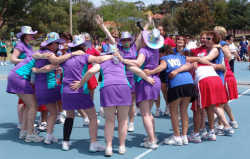Therese Banks – 7/5/99
Plan a long bus journey and you will be wise to book in advance to travel
on one of the popular luxury coaches which offer you the ultimate in luxury.
No longer does bus travel mean boarding a standard vehicle which makes no
concessions to passengers’ needs or to the demands of the route and the
length of the journey.
In the article about designline in NZine last week I emphasized the
flexibility of their designs to meet the customers’ needs. The range of long distance tourist coaches is one example showing clearly how the
designs have been adapted for different uses.
A choice of luxurious vehicles for long-distance travel designline’s super coach
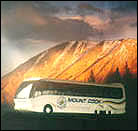 |
| Super coach Photo source designline |
This fifty seater coach is at the top end of the tour coach market and built to maximum dimensions for New Zealand roads. It is powered by a
turbo-charged Scania engine producing 363 horsepower at 2000 rpm and driving through a six stage automatic transmission.
Advantages for the passengers It’s easy to get on or off as the coach has air suspension which can lower
the front for passengers to embark or disembark. You don’t have to limit
your luggage as Scania has an enormous 12 cubic metres of capacity.
The interior is luxurious and the windows give an excellent panorama of
vision. As on aeroplanes you have your own reading lights and ventilators.
The Twin deck coach There is a special option if you are travelling from Auckland to Rotorua.
If you want to cut down on travel time and eat your meals on board you may
choose to travel on the twin deck. You’ll avoid queuing at restaurants and
also at toilets, because there’s a toilet on board. You can sit at a table
and eat your meal with friends on the lower deck.
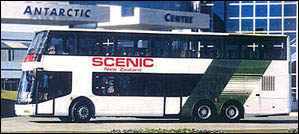 |
| The Twin Deck Coach Photo source designline |
On the upper deck the large windows offer an uninterrupted distant view.
On this coach designed for tourists you can choose a commentary available
in your choice of eight languages. You can keep in touch with home or friends and arrange for your next activities by ringing out on a card phone. You can purchase goods at the on-board shop.
The Mirage One trip on which the distant vistas and high mountains are of especial
interest is the run from Queenstown to Milford. To allow maximum uninterrupted viewing this coach has seats angled to the windows. rear seats tiered, large side windows and glass panels in the roof.
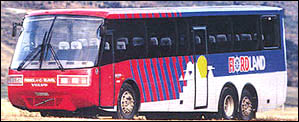 |
| The Mirage, known as the Bullet Photo source designline |
Because of its shape this unusual coach has become known as The Bullet.
Because passengers want to get out frequently to see particular views and
take photographs designline has put in an extra door half way along
one side. This makes for much faster passenger movement in and out of the
coach.
It has facilities for cordless headsets, and pre-recorded commentaries are
offered in five languages.
Ergonomic benefits for the driver While designline has incorporated all these features to improve travelling for the passenger, the designer has not overlooked the needs of
the driver. To ease the strain of driving on long trips features include an
adjustable
seat and steering wheel, a deep windscreen and a well-designed control panel.
Benefits for those who live along the bus route The people who live along the bus route are not forgotten either. The power units are built to meet Euro 2 standards relating to noise, vibration, opacity or smoke levels and pollutant emission controls and consist of long proven technology. Opacity levels are just 12 per cent.
City buses
 |
| designline city bus with ramp for wheelchairs or prams Photo source designline |
The strictly controlled levels of pollutant emissions are particularly important for the buses which designline has built for cities – large
community buses for Redbus Christchurch and Stagecoach Wellington and smaller community buses for Dunedin city.
These buses are designed with the whole community in mind and have low floors for easy access and wheelchair and pram access when required. They also have some seats facing each other to make conversation easier.
School buses While ease of conversation has not the same priority for school buses, ease
of maintenance certainly has. designline’s schoolbus meets the needs of both school children and operator, being safe for children and
simple to operate and maintain.
Flat glass screens, forward opening hinged doors, quickly replaceable panels and robust low-cost seating provide an economical solution of town
and country. In the middle of 1999 designline will supply seventy
schoolbuses to Mercedes, Australia, through a local body builder.
Surgery on wheels Not only is designline able to build seventy standard school buses
but also one-off vehicles to meet extraordinary market need. One example is
the mobile surgery which travels the length of New Zealand every twenty eight days taking to remote parts of the country, the technology for
removing kidney stones. The surgery houses the Lithotripter which is
a machine that smashes kidney stones using focussed sound waves. The bus
has automatic levelling and provides a consulting/waiting room, a kitchen
and a restroom as well as the surgery. Developing this vehicle to meet
the clients’ needs involved specialised computer technology, electrics,
electronics, hydraulics and pneumatics.
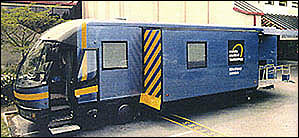 |
| The mobile surgery Photo source designline |
designline vehicles meet market need but they are built to last..
Tranzit Group will agree. The Volvo B12 travels on the Wellington/Auckland
route on a double shift, up during the day and back during the night. It clocks up 440 000 kilometres – almost half a million a year! The average motorist does just 12,000 to 15,000 kilometres yearly.
The Volvo B12 went into service in 1994 and has provided a remarkable degree of reliability and service. It has a 400 horse power engine, providing approximately 21 horsepower to the tonne. This power to weight
ratio is one of the reasons for its long life.
With a rear engine monocoque body configuration it has an electronic power
shift gear box. It is fitted with a close coupled, trailing tag axle which
has independent air suspension – all providing a high degree of comfort for
passengers. It runs on average 60 to 65 percent capacity load, that is 35
to 38 people per run.
Tranzit Group reports a high degree of satisfaction with both the Volvo
components and the designline build. The gearbox was overhauled
at approximately 900 000 kilometres. At the same time new bearings were
fitted to the engine and the injectors and fuel pump reconditioned.
Testing road conditions The coach travels the 700 kilometres between New Zealand’s two major cities. On its route are stretches of difficult terrain across the volcanic plateau
of the Desert Road in the middle of the North Island. Often the weather
conditions make driving difficult but in all weathers the coach will complete the journey.
An insight into provincial New Zealand The Volvo B12 also provides a valuable link to the cities for the small
towns on the route. Travelling by this coach in daylight gives travellers
a chance to see the changing scenery and way of life in the different communities along the way. The whole journey takes about 11 hours but there are stops for meals and refreshment during the journey.
Tranzit Group approaching seventy five year anniversary Tranzit Group will celebrate seventy five years of providing passenger transport in New Zealand in November 1999. It is a family business and
the Company Directors between them have over 120 years experience in the
coach industry.
Endorsement of the engineering based on experience Tranzit Group’s satisfaction with the engineering and body building of the
coach supplied by designline is certainly based on long experience with
passenger vehicles.
Popularity with passengers A significant verdict on the passenger appeal of designline coaches is the
growing number of bus passengers throughout the country.
Read the
next Designline article to find out about designline’s ground-breaking work
in engine design and a new service to inner city travellers.



